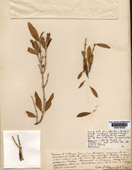
ornaments
| Short history of herbarium sheets | ||
| The origin of ornamentation | ||
| Botanists who used ornamentations | ||
| How were the ornamentations made and used? |
Short history of herbarium sheets
 |
The technique for keeping plants as dried reference specimens began in Tuscany in the 16th Century. Luca Ghini (1500-1566)introduced this method to his students at the University of Bologne. However, the preparation of herbarium specimens in this way had much earlier origins. The oldest example is probably a specimen from an olive tree (Olea europea) derived from an Egyptian pyramid dating back to the time of Ptolomy (from 305BC), see picture on the left hand. This specimen is currently housed in the herbarium at the Royal Botanic Gardens, Kew. To see this specimen larger, click here. |
> back to the top
> terug
The origin of ornamentation
| In the 18th Century botanists started to keep the individual herbarium sheets separate which allowed systematic ordering rearrangement according to developing systematic ideas. Thus it became possible to lend individual herbarium sheets and exchange duplicates. Because of this it was no longer immediately clear who the owner of a particular specimen actually was. This is perhaps the reason why ornamentations were printed onto the sheets and thus acted as an ‘ex-libris’ for the owner. The same owner also used different variations of ornamentation. It thus became a sort of 18th Century ‘revamp’ of the more traditional system. The tradition of using ornamentations in herbaria is of Dutch origin and dates back to around 1710. At the end of the 18th Century ornamentations were no longer used – they had gone out of fashion. (Did they subsequently become numbered collection-series?) > back to the top > terug |
 |
Botanists who used ornamentations
Other than George Clifford, ornamentations are known to have been used by the following people, (for more information regarding the individuals, see 'who is who':
Herman Boerhaave (1668-1738) – professor in Leiden
Johannes Burman (father) (1706-1779)– botanist at the Botanic Garden Amsterdam
Nicolaas Laurens Burman (son) – botanist at the Botanic Garden Amsterdam
Adriaan van Royen (uncle) (1704-1779) – botanist at the Botanic Garden Leiden. Unique urns with the monogram AVR.
David van Royen (nephew) - botanist at the Botanic Garden Leiden. He used unique urns with his monogram DVR.
Nicolaas Meerburgh – keeper of the Botanic Garden Leiden
David de Gorter – botanist at the Atheneum (Grammer School) at Hardewijk
Christiaan Kleynhoff – medical doctor and collector for Burman in Batavia (Indonesia)
Maarten Houttuyn (1720-1798) – medical doctor, publisher of natural history and private collector from Amsterdam.
Carl Linnaeus – took the use of ornamentations abroad
Albrecht von Haller – Basel but graduated from the Netherlands
Gronovius, Jan Frederik, there are specimens with Gronovius’s handwriting (mainly in the British Museum). There are also flowerpots with the monograph J.F.G.
> back to the top
> terug
| The different ornamentations – pots, medallions, pennants, cartouches, labels – were printed on sheets. The copper plates did not last long and only a few hundred sheets could be made from each etching. Nonetheless thousands of sheets, etchings and engravings must have been produced. Unfortunately only a few uncut sheets have survived. The few intact sheets still provide much information. Leiden owns a few complete sheets belonging to Adriaan Van Royen and it is because of these sheets that we know the names of both the designer, Hieronymus van de My (1687-1761), and the engraver, Johannes van der Speyk (1696-1763). |
 |
 |
One of vases (shown here), only known from the Clifford collection, was made by Jacobus Schijnvoet in the style of Daniël Marot (1661-1752). This vase is not found in the collections housed at Wageningen but only on sheets held at the Natural History Museum in London. An original etching of this vase is found in the Prof. Lunsingh Scheurleer collection, at the Boymans van Beuningen museum in Rotterdam. |
 |
Also the urn with two fiendish heads, present in the collections in Wageningen, is only known from the Clifford collection. |